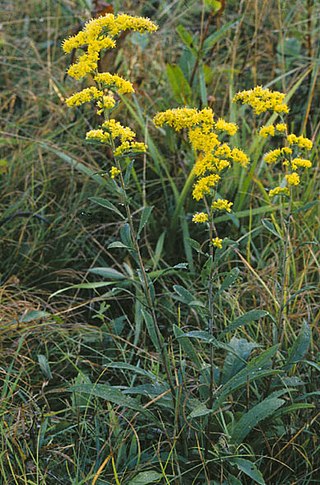
Goldenrod is a common name for many species of flowering plants in the sunflower family, Asteraceae, commonly in reference to the genus Solidago.

Prunella is a genus of herbaceous plants in the family Lamiaceae, also known as self-heals, heal-all, or allheal for their use in herbal medicine.
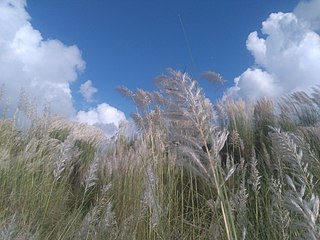
Saccharum spontaneum is a grass native throughout much of tropical and subtropical Asia, northern Australia, and eastern and northern Africa.. It is a perennial grass, growing up to three meters in height, with spreading rhizomatous roots.
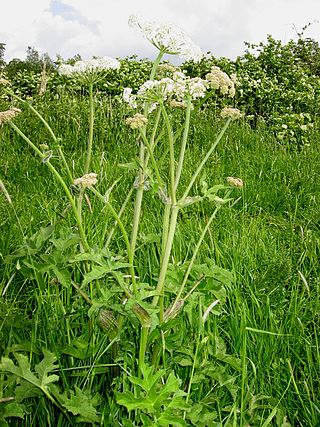
Heracleum sphondylium, commonly known as hogweed or common hogweed, is a herbaceous perennial plant in the carrot family Apiaceae, which includes fennel, cow parsley, ground elder and giant hogweed. It is native to most of Europe, western Asia and northern Africa, but is introduced in North America and elsewhere. Other common names include cow parsnip or eltrot. The flowers provide a great deal of nectar for pollinators.

Andropogon is a widespread genus of plants in the grass family, native to much of Asia, Africa, and the Americas, as well as Southern Europe and various oceanic islands.
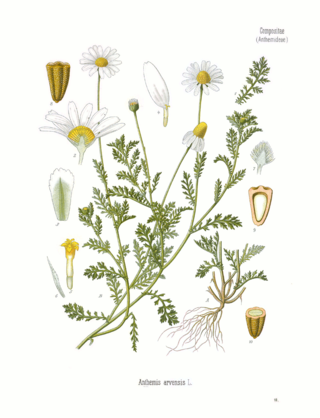
Anthemis arvensis, also known as corn chamomile, mayweed, scentless chamomile, or field chamomile is a species of flowering plant in the genus Anthemis, in the aster family. It is used as an ornamental plant.
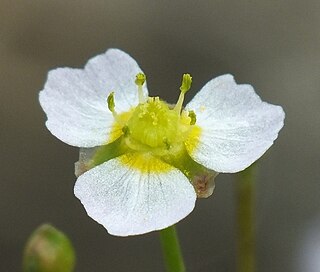
Alisma gramineum is a small aquatic plant in the water-plantain family. It has several common names including narrowleaf water-plantain, ribbonleaf water-plantain or ribbon-leaved water-plantain, and grass-leaved water-plantain. It grows in mud or submerged in shallow fresh or brackish water in marshy areas.

Vulpia bromoides, squirreltail fescue, barren fescue or brome fescue, is a species of grass in the family Poaceae. It is a winter annual native to Europe, North Africa, and West Asia, but has been introduced to parts of the America, South Africa, Australia, New Zealand and isolated parts of East Asia.

Calligonum is a genus of plants in the family Polygonaceae with about 80 species across the Mediterranean Sea region, Asia and North America.
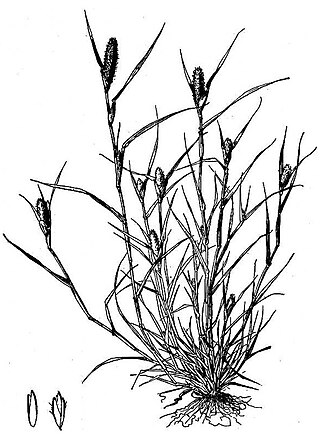
Crypsis is a genus of African and Eurasian plants in the grass family, sometimes referred to as pricklegrass. These are annual grasses with short leaves. A few species are invasive weeds outside their native ranges.

Eleocharis quinqueflora is a species of spikesedge known by the common names fewflower spikerush and few-flowered spike-rush. It is widespread across Europe, North Africa, northern Asia, and North America. There are also isolated populations in Argentina and Chile.

Pseudoroegneria spicata is a species of perennial bunchgrass known by the common name bluebunch wheatgrass. It is native to western North America.

Halophila is a genus of seagrasses in the family Hydrocharitaceae, the tape-grasses. It was described as a genus in 1806. The number of its contained species, and its own placement in the order Alismatales, has evolved.

Danthonia decumbens is a species of grass commonly known as the heath grass, heath-grass, or staggers grass It is a tussock grass native to Europe and adjacent parts of Asia and North Africa. It may also be native to Newfoundland and Nova Scotia.

Taeniatherum is a genus of Eurasian and North African plants in the grass family.

Tripidium ravennae, synonym Saccharum ravennae, with the common names ravennagrass and elephant grass, is a species of grass in the genus Tripidium. It is native to Southern Europe, Western Asia and South Asia. It is known in North America as an introduced species, where it is sometimes an invasive and troublesome noxious weed.

Euphorbia caput-medusae is a plant of the genus Euphorbia that occurs in and around Cape Town, South Africa.
Medusahead is the common name of more than one species of plant, including:
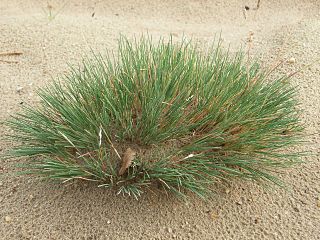
Corynephorus canescens, common name grey hair-grass or gray clubawn grass, is a species of plants in the grass family, native to Europe, the Middle East, and North Africa but widely naturalized in North America. In the United Kingdom it is rare. It can be found at sites such as Wangford Warren and Carr, a Site of Special Scientific Interest in the Breckland area of Suffolk.

Ceratocarpus is a genus of flowering plants in the family Amaranthaceae. It has only one currently accepted species, Ceratocarpus arenarius, found in Bulgaria, Romania, Crimea, Russia, Anatolia, the Caucasus, Iran, Afghanistan, Pakistan, Central Asia, the Altai, western Siberia, Xinjiang in China, and Mongolia. A bushy herbaceous plant, no more than 30 cm tall, it is a valuable fodder for sheep, goats and horses, and it grows well in degraded and trampled soils.




















